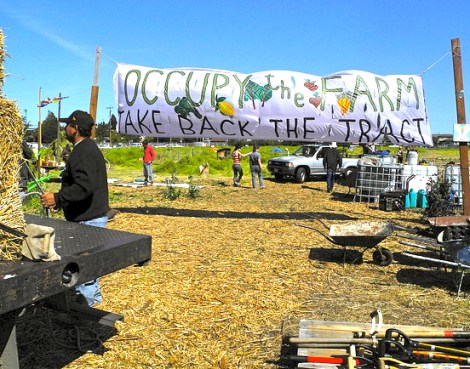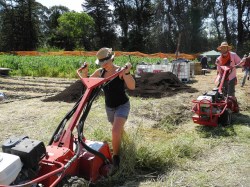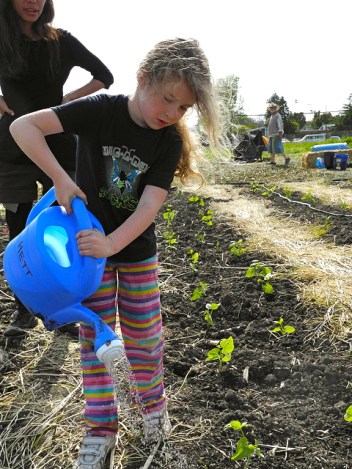This post originally appeared on the Earth Island Journal website.

All photos by Jeff Conant/Climate Connections.
It doesn’t take an agricultural expert to know that you can’t grow vegetables without water. So it wasn’t surprising that after hundreds of people marching under the banner “Occupy the Farm” took over a University of California (UC) agricultural testing station on the edge of Berkeley, Calif., April 22, UC officials responded by shutting off water to the site. The next day, a late-season storm brought a half-inch of rain to the San Francisco Bay Area, irrigating the thousands of vegetable starts in the ground and lifting the spirits of the urban farming activists who are determined to save the site from development. Score: Occupiers, 1 — UC administrators, 0.
Social change activists in Berkeley, Calif., have always been ahead of the curve. Today, May Day, is the spring reemergence for the Occupy movement as activists around the United States engage in work stoppages, street marches, and various forms of civil disobedience to press their demands for a more equitable economy. The folks with Occupy the Farm got started early. On Earth Day, they marched from Berkeley’s Ohlone Park to a five-acre plot of land in the adjacent bedroom community of Albany. They cut the locks on the gates of the UC-Berkeley and U.S. Department of Agriculture (USDA) field trial plot, pulled up nearly an acre of thick mustard growing there, and got busy working the soil with a pair of rented rototillers. Then, scores of volunteers planted 150-foot rows of lettuce, beans, cucumbers, and leafy greens. By the end of Earth Day, the Bay Area had a new urban farm.
The occupation of the Gill Tract (named for the family that donated the property to the university decades ago) appears to mark a new stage for the adolescent Occupy movement. The autumn encampments in Manhattan, Oakland, and dozens of other cities around the country were a kind of primal scream against the growing wealth disparities and corporate overreach that have come to characterize America. With their anarchist architecture and consensus decision-making, Occupy’s autonomous spaces gave people a chance to envision a radically different way of organizing society and economy — and in the process shifted the national discourse in a more progressive direction. Now, actions like the Gill Tract takeover, the occupation of foreclosed homes, and the protests outside of bank shareholder meetings are giving new potency and political relevance to the Occupy movement. Occupiers (some of them at least) are beginning to focus on actions that are at once full of political symbolism and fulfill people’s basic human needs for food and shelter. Activists have gone from imagining a new world to actually creating it.
“While those of us who originally organized this aren’t affiliated with the official Occupy movement, we are inspired by the last year of what Occupy has done,” Anya Kamenskaya, one of the Occupy the Farm organizers, told me when I visited the Gill Tract Friday morning. “We are taking that Occupy spirit and taking it to the problems in our community. You could call it Occupy 2.0”
 Kamenskaya is a UC-Berkeley alum (class of 2009) who has been involved in sustainable agriculture initiatives such as The Greenhorns and Future Farmers. As we spoke, a convoy of borrowed pickup trucks was dumping load after load of dark black compost next to where a dozen straw bales had just been dropped off. Volunteers were busy painting banners for an upcoming weekend of community farming events. A flock of six laying hens pecked about among the trampled mustard stalks. “The reason we’re here is because it’s farmland, and it’s farmland in an urban area, and it should be used as farmland, especially since there are tens of thousands of people in the Bay Area who are food insecure,” Kamenskaya, wearing a floppy straw hat, said as she directed the delivery of some port-a-potties. “For years students, professors, and neighbors have come up with proposal after proposal for some kind of agro-ecology center to show people how to grow their own food. The university has had listening sessions so they can say they have listened. But they don’t incorporate our ideas into their plans.”
Kamenskaya is a UC-Berkeley alum (class of 2009) who has been involved in sustainable agriculture initiatives such as The Greenhorns and Future Farmers. As we spoke, a convoy of borrowed pickup trucks was dumping load after load of dark black compost next to where a dozen straw bales had just been dropped off. Volunteers were busy painting banners for an upcoming weekend of community farming events. A flock of six laying hens pecked about among the trampled mustard stalks. “The reason we’re here is because it’s farmland, and it’s farmland in an urban area, and it should be used as farmland, especially since there are tens of thousands of people in the Bay Area who are food insecure,” Kamenskaya, wearing a floppy straw hat, said as she directed the delivery of some port-a-potties. “For years students, professors, and neighbors have come up with proposal after proposal for some kind of agro-ecology center to show people how to grow their own food. The university has had listening sessions so they can say they have listened. But they don’t incorporate our ideas into their plans.”
The land seized by Occupy the Farm is the last parcel of Class 1 — the most desirable — agriculture soil left in the East Bay and the final remnant of a 104-acre spread bequeathed to the University of California in the 1920s. For decades this sliver of prime farmland has been used as an agricultural testing station by researchers from the USDA and UC-Berkeley’s College of Natural Resources. But a 2004 UC Master Plan for the area proposes a “commercial redevelopment” for the site. World War II era buildings on the south end of the property are slated to be turned into housing for UC faculty and graduate students, as well as retail space (including, ironically, a Whole Foods). The land currently used for agricultural trials would be re-zoned for “open space and recreation” and could include the construction of little league fields, a community center, or a childcare facility.
The Occupiers say getting rid of this final vestige of farmland would be a horrible mistake: “Farmland is for farming,” Occupy the Farm said in an April 26 statement. “We cannot allow the UC to destroy one of the best resources for urban agriculture in the Bay Area.”
In an open letter published Friday, UC officials said that they “have welcomed community workshops to explore future use of this land” and “are open to further discussions with the community about implementation of the Master Plan.” At the same time, university administrators expressed resentment with the Occupiers’ tactics. “We take issue with the protesters’ approach to property rights,” the letter said. “By their logic, they should be able to seize what they want if, in their minds, they have a better idea of how to use it.”
On Monday, Dan Mogulhof, head of UC’s public affairs office, told me that it’s unfair of the Occupiers to think they are the only ones with hopes for the property. “We are big believers in metropolitan agriculture,” Mogulhof said. “A lot of our professors, students, and administrators are involved [in urban farming.] But there are a variety of competing interests here. We can’t be marching to the interest of just one group. We have to be representing the full range of community interest.”
 Occupy the Farm organizers counter that many Albany residents and Gill Tract neighbors have expressed their desire for a community farm at the site — but that the university has failed to listen. As far back as 1997, professors, students, neighbors, and a collection of more than 40 nonprofit organizations presented UC with a detailed proposal for an urban agriculture center at the farm. Occupiers also point to the enthusiasm they have received from neighbors during the past week as evidence of community support: Since UC officials shut off water to the site, Occupiers have been irrigating the crops with water donated by nearby residents. And scores of residents, many with children in tow, have visited the encampment.
Occupy the Farm organizers counter that many Albany residents and Gill Tract neighbors have expressed their desire for a community farm at the site — but that the university has failed to listen. As far back as 1997, professors, students, neighbors, and a collection of more than 40 nonprofit organizations presented UC with a detailed proposal for an urban agriculture center at the farm. Occupiers also point to the enthusiasm they have received from neighbors during the past week as evidence of community support: Since UC officials shut off water to the site, Occupiers have been irrigating the crops with water donated by nearby residents. And scores of residents, many with children in tow, have visited the encampment.
“We had so many community members come out this weekend,” said organizer Ashoka Finley, another UC-Berkeley alum, who has worked as a garden educator since he graduated in 2010. (Full disclosure: Finley is a student in the organic gardening course I co-teach with another Gill Tract Occupier, Antonio Roman-Alcala, at San Francisco’s Alemany Farm.) “Kids were being led through the farm by their parents. We started a permaculture garden with community input and support. We had face painting. Someone brought some goats, so we had a little petting zoo.”
The Occupiers have enlisted another important ally to help make their case: UC professor Miguel Altieri, a global leader in the science of agro-ecology. Altieri has been running field trials at the Gill Tract since 1981, longer than any other researcher, and so he has one of the strongest claims to the site. “The master plan of the university is obscure,” Altieri told me. “They say it’s going to go from academic to recreational use. That could be baseball fields or whatever. This could be a huge opportunity for the university to play a huge role in urban agriculture, to create a center for urban agriculture that could show how you can reduce transportation, and lower emissions, by producing food in cities.”
In an essay that he submitted to the Daily Cal campus newspaper, Altieri and another professor, Claudia Carr, argue that as a land-grant university, UC has a tripartite mission — to educate students, to undertake research, and to share that research with the public through Cooperative Extension programs. An urban farm that balances undergraduate classes, graduate level research, and food production for the community would fulfill all of those functions.
UC officials appear to be listening. According to Mogulhof, on Friday afternoon, J. Keith Gilless, dean of the college of natural resources, met with Occupiers and told them “the university is more than happy to talk about shared custody for this growing season as long as the agricultural research can continue” and the overnight encampment ends.
If the Occupiers are able to grow food at the Gill Tract this summer — and then use that foothold to achieve their larger aims — it would mark an important win for the Occupy movement. It would, for starters, demonstrate the power of community organizers to make a demand to the powers that be and then see it through to victory. It would demonstrate how to take control of public spaces, not just for symbolic reasons, but for productive purposes. It would demonstrate the time and patience required for real social change (the Gill Tract occupation was six months in the planning). And, perhaps most important, it would demonstrate that communities already possess the resources they need to build a more just and sustainable world.
This last point was made clear to me by veteran activist Gopal Dayaneni as I was leaving the encampment on Friday. “We don’t need corporations and we don’t need gene research to tell us how to farm,” he said. “We’ve been doing it for thousands of years. We just have to remind each other how to do it.”



